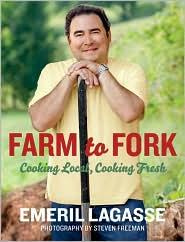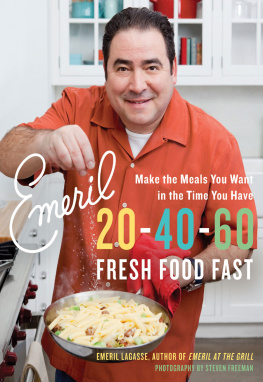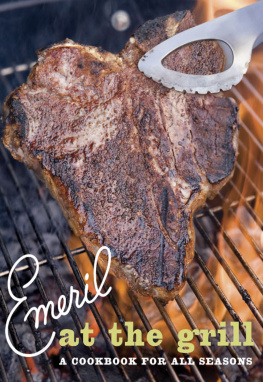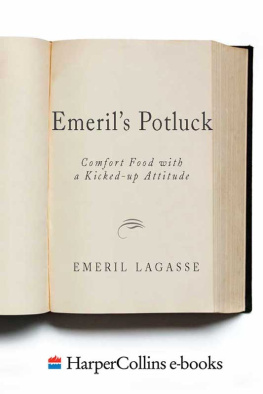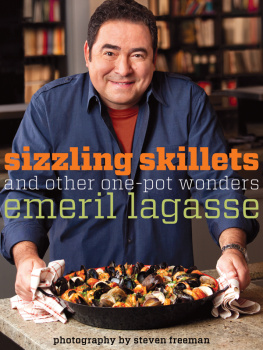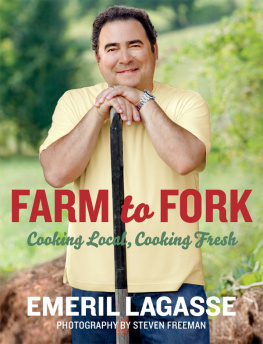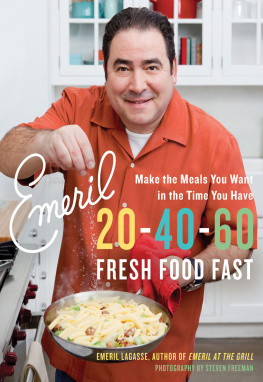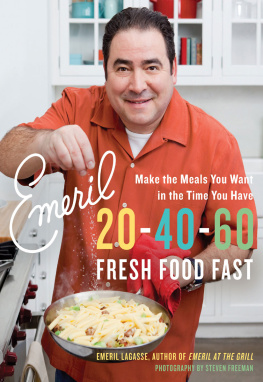Emeril Lagasse - Farm to Fork: Cooking Local, Cooking Fresh
Here you can read online Emeril Lagasse - Farm to Fork: Cooking Local, Cooking Fresh full text of the book (entire story) in english for free. Download pdf and epub, get meaning, cover and reviews about this ebook. year: 2010, publisher: HarperCollins, genre: Home and family. Description of the work, (preface) as well as reviews are available. Best literature library LitArk.com created for fans of good reading and offers a wide selection of genres:
Romance novel
Science fiction
Adventure
Detective
Science
History
Home and family
Prose
Art
Politics
Computer
Non-fiction
Religion
Business
Children
Humor
Choose a favorite category and find really read worthwhile books. Enjoy immersion in the world of imagination, feel the emotions of the characters or learn something new for yourself, make an fascinating discovery.
- Book:Farm to Fork: Cooking Local, Cooking Fresh
- Author:
- Publisher:HarperCollins
- Genre:
- Year:2010
- Rating:3 / 5
- Favourites:Add to favourites
- Your mark:
- 60
- 1
- 2
- 3
- 4
- 5
Farm to Fork: Cooking Local, Cooking Fresh: summary, description and annotation
We offer to read an annotation, description, summary or preface (depends on what the author of the book "Farm to Fork: Cooking Local, Cooking Fresh" wrote himself). If you haven't found the necessary information about the book — write in the comments, we will try to find it.
Farm to Fork: Cooking Local, Cooking Fresh — read online for free the complete book (whole text) full work
Below is the text of the book, divided by pages. System saving the place of the last page read, allows you to conveniently read the book "Farm to Fork: Cooking Local, Cooking Fresh" online for free, without having to search again every time where you left off. Put a bookmark, and you can go to the page where you finished reading at any time.
Font size:
Interval:
Bookmark:
This book is for all the farmers and fishermen who keep on keepin on. We are so proud of what you do.
Thank you.


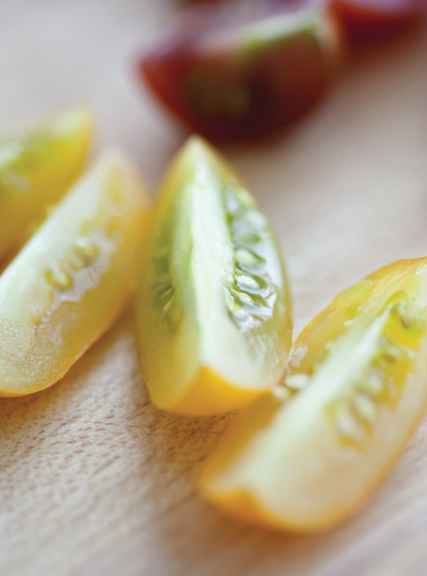
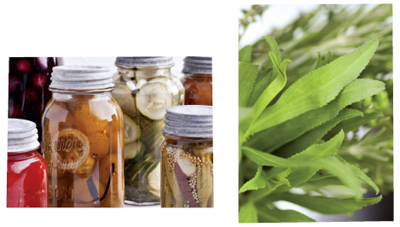
I HAVE HAD A CONNECTION WITH THE SOIL SINCE I WAS A YOUNG BOY.
This was kindled long ago, when Dad and I would visit my Uncle Olivers farm in Westport, Massachusetts. I really looked up to Uncle Oliver, who made his living by growing and baling hay and raising hogs, chickens, goats, sheep, as well as growing fruits and vegetables. I remember being very happy walking the strawberry rows in springUncle Oliver allowed me to pick to my hearts content. I was also encouraged to help in the harvesting of beans, peppers, zucchini, cucumbersyou name itand then looked forward to every fall for the arrival of cole crops, potatoes, and the magic of pumpkins.
This must have inspired Dad, too, because not much later he converted a good acre-plus of our backyard in Fall River into a vegetable garden, which we tended together. What we didnt eat or share with friends and family was put into my little red wagon and peddled around the neighborhood, particularly to Genes Market, just a couple blocks from home.
As I got older, I began to take part in the milking of cows and goats and collecting eggs from the chicken coop. It was this experience that really taught me how a farm works. I made the connection between the food we buy at the market and the people who grow it, and that really stuck with me. Once I became a chef and began honing my craft, I knew the most important thing was to use the freshest and the best ingredients I could find. I also recognized that those ingredients, whether they be seafood, meat, poultry, or produce, should be grown and harvested locally.
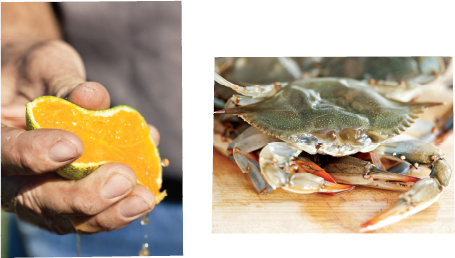
A lesson from an early age of what makes great food.
By 1983, when I came to Louisiana and was given a chance to make a name for myself at Commanders Palace in New Orleans, local ingredients were what I relied upon and how I became inspired. It was during those early years as a chef that I, along with a few other chefs and a great farmer, started a farm co-op in nearby Mississippi. The result was fresh produce and herbs straight from the farm and the beginning of hog Wednesdays. On that day, our farmer would bring freshly slaughtered pigs to the restaurant, and we used every part in every which waya tradition that remains at Emerils Restaurant in New Orleans to this day. We took great pride in the fact that everything we made was completely from scratch: from goat cheese to ice cream, from Worcestershire sauce to house-cured bacon. And twenty years later, the focus remains the same for me: fresh quality ingredients make for good food and an exceptional quality of life. My passion for fresh farm-grown ingredients continues to grow stronger. All of the chefs who work in each of my restaurants around the country carry on the tradition of using the freshest ingredients and of maintaining long-lasting connections with local farmers. It is this principle that has inspired the recipes youll find in these pages: recipes that rely on simple techniques to really allow the integrity of the food to shine through.
Buy fresh, Buy local is a slogan that both my restaurants and my family try to live byand a very important message that I feel compelled to pass along to folks as I encounter them in my travels each day. I try to instill this in my kids by bringing them with me when I shop for family meals. Not only is it fun for them to help Dad pick out the produce, but they also get a lesson in forging relationships with the people who work hard to provide it. It is also the perfect time to speak to them about why its important to...
Support your local farmers markets.
With the constraints placed on farmers in this country, we really do owe it to ourselves and to them to give our support. If you can, try to find farmers who take the harder road and grow organicallyyour familys health, not to mention a better ecosystem and a lighter carbon footprint, will be your reward. With more than 4,500 farmers markets nationwide, and more popping up every day, there is really no reason not to support our local markets. The vendors are able to showcase the very best of what is in season locallysmall dairies sell milk, cream, and cheese from cows living perhaps only a few miles away, and farmers bring in produce that heralds the arrival of each season. How exciting it is to see these products on our tables, picked at the peak of ripeness and full of nutrients and vitality. It doesnt get much better than this. An added bonus is that there is no excess packaging to recycle, and no annoying little stickers to pry off your fragile produce. Also, small farmers often grow different and unusual, often heirloom, varieties of produce that many of us have not seen in our lifetimes but which probably graced the tables of the family that went before us.
Our local farmers markets often support not only farmers but also the men and women who brave the local waters to bring us freshly caught fish, shrimp, crabs, oysters, and a host of other treasures. There has been much in the news lately (but not nearly enough) about the hard times these folks are having competing with the low prices of seafood imported from China and other countries. I know firsthand that Gulf Coast shrimpers are really hurting in this regard; the prices that they are offered at the docks dont even cover their operating costs. Families who have been fishing and shrimping for generations are now being forced to find different livelihoods. If we want to continue to enjoy the wonderful seafood that these people work hard to bring to us, then we must make different choices about where we purchase our seafood. Simple as that.
The way I see it, its returning to a way of life that used to be taken for granted. Buy locally and you are able to enjoy the benefits that come along with it. Plant a small garden in your backyard, or even just an herb garden in pots on a windowsill. Either way, talk about a great way to spend time with the family! And hey, finicky children are much more likely to try a new vegetable if theyve taken part in growing it. The wonder of planting a seedling, watching it grow, and harvesting it to eat is inexplicable. I cant think of a better way to show a child the value of fresh food from the table.
Some of us living in urban environments may not feel we have the opportunities for gardening and farming at home, and may feel unconnected to the sources of our food. But urban farms are popping up in the most unlikely places, such as the still struggling post-Katrina 9th ward of New Orleans. Previously blighted properties are now hosting thriving gardens, where abandoned car tires find new life as containers for vertical potato gardening. (Yes, Ive seen it!) New Orleans is home to many such urban farms these days, and these projects not only bring life into neglected parts of town but also enrich the local communities by giving neighbors a reason to come together and work toward a common goal. I know this is happening across the nation, and the message Im getting to is this: there is a limit only if we allow ourselves to imagine one.
Font size:
Interval:
Bookmark:
Similar books «Farm to Fork: Cooking Local, Cooking Fresh»
Look at similar books to Farm to Fork: Cooking Local, Cooking Fresh. We have selected literature similar in name and meaning in the hope of providing readers with more options to find new, interesting, not yet read works.
Discussion, reviews of the book Farm to Fork: Cooking Local, Cooking Fresh and just readers' own opinions. Leave your comments, write what you think about the work, its meaning or the main characters. Specify what exactly you liked and what you didn't like, and why you think so.

